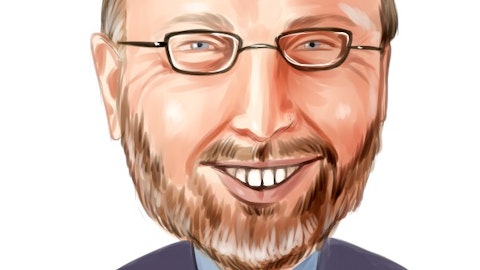Clarivate Plc (NYSE:CLVT) Q4 2023 Earnings Call Transcript March 1, 2024
Clarivate Plc isn’t one of the 30 most popular stocks among hedge funds at the end of the third quarter (see the details here).
Operator: Hello, all, and welcome to Clarivate’s Fourth Quarter and Full Year 2023 Earnings Call. My name is Lydia, and I’ll be your operator today. [Operator Instructions] I’ll now hand you over to Mark Donohue, Head of Investor Relations, to begin.
Mark Donohue: Thank you, Lydia. Good morning, everyone. Thank you for joining us for the Clarivate fourth quarter and full year 2023 earnings conference call. As a reminder, this conference call is being recorded and webcast, and is copyrighted property of Clarivate. Any rebroadcast of this information in whole or in part without prior written consent of Clarivate is prohibited. An accompanying earnings call presentation is available on the Investor Relations section of the company’s website clarivate.com. During our call, we may make certain forward-looking statements within the meaning of applicable securities laws. Such forward-looking statements involve known and unknown risks, uncertainties and other factors that may cause the actual results, performance or achievements of the business or developments in Clarivate’s industry to differ materially from the anticipated results, performance, achievements or developments expressed or implied by such forward-looking statements.
Information about the factors that could cause actual results to differ materially from anticipated results or performance can be found in Clarivate’s filings with the SEC and on the company’s website. Our discussion will include non-GAAP measures or adjusted numbers. Clarivate believes non-GAAP results are useful in order to enhance an understanding of our ongoing operating performance. But they are supplement to, and should not be considered in isolation from, or as a substitute for, GAAP financial measures. Reconciliations of these measures to GAAP measures are available in our earnings release and supplemental presentation on our website. With me today are Jonathan Gear, Chief Executive Officer; and Jonathan Collins, Chief Financial Officer.
Both will be available to take your questions at the conclusion of the prepared remarks. After prepared remarks, we’ll open the call up. With that, it’s a pleasure to turn the call over to Jonathan Gear.
Jonathan Gear: Great. Thank you, Mark. Good morning, everyone, and thanks for joining us today. As I begin my second full financial year as CEO of Clarivate, I would like to provide an update on our turnaround journey, including the timing and actions required in the years ahead. 2023 was a critical year for Clarivate as we executed significant changes. These changes allowed us to set the foundation for future growth. I will cover some of these changes on the next slide. It also was a year where we were impacted by macro pressures that, to varying levels, impacted each of our segments and contributed to lower organic growth than originally expected. Nonetheless, these changes were required to set us up for the next phase of Clarivate, where we innovate for growth.
Beginning on prior investments and changes, we expect to see continued progress in Academia & Government and new success in our focus areas in Intellectual Property and Life Sciences & Healthcare. This will accelerate in 2024 into 2025. We expect new product introduction to lead to increased renewal rates, new sales, better ability to capture pricing and drive revenue growth. I now fully expect us to exit 2025 positioned to drive value as we couple mid-single digit organic growth with our scaled business model to accelerate our ability to be a cash generation machine for investors. I should acknowledge that this revised outlook is a year longer than the plan I set forth at Investor Day last year. The macro environment hampered us in 2023 and we pivoted our strategy in Life Sciences & Healthcare under a new leader.
Nonetheless, with one year under my belt and the changes complete, I am more confident than ever in the potential for Clarivate’s success and growth. 2023 was a foundational year for Clarivate. It was a year where we drove significant changes in three areas to position us for growth. Prior to 2023, our operating model was primarily aligned by function and this allowed us to rapidly realize cost synergies from the three large acquisitions completed over the prior few years. However, there were trade-offs, namely less accountability and a fragmented key account management strategy. I recognized that we needed to drive more accountability and build a more effective way of operating closer to our customers. From this view, we created our segment operating model to tighten our customer focus, accelerate decision making and bring innovations to market faster.
The result was an organizational alignment into three segments: Academia & Government, Intellectual Property, and Life Sciences & Healthcare. In May 2023, I appointed Presidents to lead each segment. I hired two external industry leaders, Bar Veinstein to run Academia & Government, and Henry Levy to run Life Sciences & Healthcare. I reassigned Gordon Samson from his role as Chief Product Officer to run the IP segment, an industry in which he’s had nearly a decade of experience. With new, experienced leadership in place that has full accountability for their respective segment P&Ls, including sales, go-to-market, product leadership, technology and operations, we are in a better position to drive improved performance across the organization. At our Investor Day, we highlighted the lack of investment in flagship products and innovation over several years, which we needed to reverse.
We commenced a significant level of investment and executed against a roadmap to reinvigorate our portfolio. This includes creating new products, enhancing existing solutions, and accelerating the use of artificial intelligence to move faster, be more agile, and bring solutions to market more quickly. Starting in 2023, we increased our annual capital investment by around $40 million, an increase of around 20% to propel product innovation across all segments. We are seeing early evidence that these investments are paying off. The reinvigoration of Web of Science, where we made the earliest investments, is our first example as that platform has returned to growth with further growth acceleration expected. Patent Intelligence Services in IP is our second example.
We hired a new product team in late 2022. They engaged deeply with our customers in the first half of 2023 and began executing against a roadmap to reinvigorate this platform. We plan to take it to market in first half of 2024, and look forward to sharing KPIs with you in future calls. In Life Sciences & Healthcare, we made a major pivot on our real-world data platform after the arrival of Henry Levy. We invested in a new focused strategy in the second half of 2023 and expect to share initial customer wins later in the year. Finally, and related to our new org structure, we renewed a focus on aligning with our customers and supporting their success. I myself hosted nearly 100 customer meetings in 2023 and learned what we are doing well and what we can do better.
As a result, we realigned our customer facing teams including sales, marketing, customer care with the product teams, ensuring our differentiated industry expertise is front and center in every customer interaction. With the foundation now built, over the next two years, we will focus on specific organizational and segment priorities to improve organic growth to a low single digit range. First, with our organizational wide priorities, with our segment model now in place for a year, we are better equipped to drive excellence across Clarivate to build a winning culture, focus on innovation, customer centricity and accountability. We will continue to pursue operational efficiencies, including utilizing AI and its many benefits to further enhance productivity.
This will help us maintain and improve our operating margins, while still investing in innovation. It will also help us generate even stronger cash flow to reduce our leverage to the low 3 times range. Finally, we are actively evaluating opportunities to prune the portfolio of smaller diluted products. This will sharpen our focus on core growth markets and generate cash to reinvest in our business and reduce our debt. Moving on to our segment priorities. Our prior-year investments in the Web of Science have delivered improved usage and renewal rates. With additional product innovation, we are targeting enhanced performance across content aggregation within the A&G segment. In addition, we continue to pursue advancements in AI as well as in business development opportunities such as acquisition — sorry, our acquisition of Alethea, an AI student engagement solution.
In 2023, our IP segment experienced some of the most challenging economic and budget pressures in years. This has now stabilized and we expect improvements in second half of 2024 as we lap the prior year comps. Last year, we launched two new AI-powered workflow solutions, the Brand Landscape Analyzer and an IP forecast tool. We look forward to launching our new IP intelligence platform this year and extend our current IP management system win rates through service integration with AI-enabled workflows. Our Life Sciences & Healthcare segment, which has the greatest upside potential, has been our most volatile business over the last two years. While this segment also experienced macro headwinds last year, we believe the growth potential far exceeds our other two segments.
With a change in leadership and the change in our go-to-market strategy it has brought, we are now better positioned to optimize the long term success of the analytics platform. In addition, on prior earnings calls, we discussed the investments we are making to drive innovation across our real-world data platform, supported by generative AI functionality. The increase in capital spending in 2024 is primarily targeted to accelerate innovation within this very important high-growth segment. Each of our Presidents looks forward to sharing more details on these growth strategies over a series of upcoming investor webinars. We will be sharing more details on the timing of these events soon. As we exit this year, we will be well on our way in our transformational journey.
Under our updated outlook, we believe we can achieve our mid-single digit organic growth target in 2026. This is approximately one year longer compared to the targets we provided last March. We, of course, will continue to look at every opportunity to accelerate this timeline. I’m confident that we have the people, customer relationships, products and solutions to succeed. By achieving a mid-single digit growth rate, we will be well positioned to deliver margin accretion, stronger cash flows, capital allocation optionality and deliver significant value for our shareholders. I now want to briefly discuss our 2023 financial results. Even in a challenging growth year, we improved on our underlying financial position. Organic subscription revenue grew more than 2% in 2023 and we achieved record renewal rates of 92%.
We generated our highest free cash flow ever at more than $500 million, of which $300 million was allocated towards accelerated debt repayment, dropping our leverage ratios below 4 times. We also repurchased $100 million of our ordinary shares. With an improving balance sheet and strong cash generation, we continue to invest in CapEx spending to drive additional product innovation. We will continue to be disciplined in capital allocation and currently expect to use approximately $400 million, primarily for deleveraging in 2024. I want to thank all of my colleagues for their ongoing dedication in helping Clarivate achieve its full potential. I’m confident that the significant structural and operational changes we made last year have created the path to accelerate and sustain organic revenue growth.
I look forward to updating you on the progress in the quarters ahead. With that, let me now turn the call over to Jonathan Collins to walk you through our financials.

Jonathan Collins: Thank you, Jonathan. Good morning, everyone. Slide 12 is an overview of last year’s fourth quarter and full year financial results compared with the same periods from the prior year. Q4 revenue was $684 million, an increase of $9 million versus 2022, bringing the full year to $2.629 billion, a decrease of $31 million compared to the prior year. The decline was entirely due to the MarkMonitor divestiture and was partially offset by favorable foreign exchange. The fourth quarter net loss was $863 million due to the non-cash goodwill impairment charge related to the legacy businesses in the IP and LS&H segments. This was also the primary driver of the full year net loss of $987 million, which was an improvement of $3 billion over 2022, as this year’s non-cash goodwill impairment charge was lower than the one recorded in the prior year.
Adjusted diluted EPS, which excludes the impact of one-time items like the impairment, was $0.23 in Q4, a $0.01 improvement over the same period last year. The full year result was $0.82, $0.03 lower than 2022, stemming from the MarkMonitor divestiture. Operating cash flow was $191 million in the quarter, an increase of $54 million over the prior year’s fourth quarter as the working capital timing issue from the third quarter unwound. Full year operating cash flow improved $235 million, or 46% over 2022, to nearly $0.75 billion on lower one-time cost and working capital requirements. Please turn with me now to Page 13 for a closer look at the drivers of the full year top- and bottom-line changes from the prior year. On our Q3 earnings call, we indicated Q4 organic growth was expected to approach 1%.
However, it came in slightly below those expectations, closer to flat. Q4 has historically been the largest transactional sales quarter of the year for our A&G segment, and the outcome for this area was modestly lower than not only our expectations, but also the prior year’s results. Adjusted EBITDA was right in line with our expectations despite the modestly lower revenue. The full year changes to the top- and bottom-line were driven by the four key factors highlighted on this chart. First, revenue was up $7 million on organic growth of 0.3%. Despite the softer year-end transactional sales, A&G accelerated growth on the back of the research and analytics subsegment as we reap the benefits of the investments in the Web of Science product. Our LS&H segment declined, led by a double-digit drop in transactional revenues due to the challenges with our legacy strategy of selling our real-world data that we discussed in prior calls and is in the process of being addressed.
Finally, our IP business was down slightly in our Patent Intelligence solutions, which is also being reinvigorated in 2024, as well as previously discussed macro-related softness in our patent renewals and trademark services’ offerings. The adjusted EBITDA impact was negligible as we were able to achieve efficiencies that offset most cost inflation. Second, inorganic impacts, namely the divestiture of the MarkMonitor business in 2022, lowered revenue $63 million and profit $32 million last year. Third, cost synergies from the ProQuest acquisition contributed $40 million of incremental profit and not only buoyed profit margins but were completely responsible for the expansion over the prior year. And, finally, the foreign exchange translation impact of non-US dollar denominated subsidiaries increased revenue by $25 million compared to 2022.
The profit increase was negligible as transaction gains were lower than the prior year. Please turn with me now to Page 14 to step through the conversion from adjusted EBITDA to free cash flow at the highest rate we’ve seen since the IPO in 2019. Free cash flow was $127 million in the fourth quarter, an increase of $36 million over the same period the prior year, bringing the full year amount to more than $0.5 billion, growth of nearly $200 million over 2022, which represented an 18 percentage point improvement in the conversion on adjusted EBITDA. The majority of the improvement, $155 million, was caused by lower one-time cost as we completed the integration of the acquisitions. Interest payments were up $22 million over the prior year as the impact of base rate increases was partially offset by the lower debt quantum due to the deleveraging in Q4 of 2022 and H1 of 2023.
Cash taxes were $21 million lower than the prior year as we recognized the benefit of planning initiatives, jurisdictional mix and the timing of payments. Working capital was a $5 million source of cash compared to a $73 million use the prior year. The timing of payments within our patent renewal business in our IP segment was a meaningful contributor to the year-over-year improvement. Capital expenditures rose $40 million to nearly $0.25 billion, or 9% of revenue, as we ramped up our investment in product innovation. We used our free cash flow to service our preferred stock with a dividend, prepay $300 million of term debt, and repurchased 14 million shares of our common stock. This balanced capital allocation brought our net leverage ratio to our year-end target of less than 4 turns.
Please move with me now to Slide 15 as we turn the page on 2023 and provide our guidance for 2024. Beginning at the top of the page, we expect organic growth to improve over last year to about 1% at the midpoint of our range. From a segment perspective, we anticipate A&G’s growth will continue to improve modestly, LS&H to improve to about flat, and IP to return to low growth. In terms of revenue types, we expect the subscription file will grow between 2% and 3%, in line with last year, reoccurring to grow about 1%, and transactional to decline about 2%. It’s worth noting that we expect to be off to a slower start in Q1 with a decline of more than 2%. While we anticipate the subscription file will continue to grow, we’re likely to see high-single-digit declines in both the reoccurring and transactional order types, driven by tougher comps in our IP segment, namely patent renewal and trademark servicing volumes.
We expect organic growth to be modestly positive, excluding these product areas, and our full year guidance predicts positive organic growth for each of the remaining quarters of this year. 1% organic growth for the full year would yield revenue of about $2.62 billion at the midpoint of the range. Moving down the page, we expect adjusted EBITDA in the range of $1.055 billion to $1.115 billion, resulting in a profit margin of about 41.5% at the midpoint of the range. We anticipate diluted adjusted EPS between $0.70 and $0.80, down $0.07 from last year at the midpoint. The adjusted EBITDA decline, which I’ll detail on the next page, will account for about $0.04 and higher D&A from increased capital spending to drive growth will cause $0.03. And, finally, at the bottom of the page, we anticipate free cash flow between $420 million and $500 million.
Please turn with me now to Page 16 for a closer look at the full year top- and bottom-line changes we’re expecting compared to last year. Since the benefit of the cost synergies from the ProQuest acquisition are completely embedded in last year’s results, the full year change to revenue and adjusted EBITDA of this year is driven by three key factors. First, organic growth at the midpoint of our guidance range will add about $30 million to the top-line, but will have no impact on the bottom-line, leading to a modestly lower profit margin as we remain committed to investing in product innovation that we believe will accelerate organic growth in the coming years. Second, the inorganic impact from selling a small business line in the IP segment will remove some revenue this year compared to last year.
We expect the transaction will close this quarter and will deduct about $30 million of revenue and about $15 million of profit this year. As Jonathan highlighted earlier, pruning the portfolio of small growth dilutive products to improve execution is a priority to accelerating our organic growth, and this is another step in this direction. And, finally, we anticipate a $10 million in foreign exchange translation headwind on the top-line and a slightly higher headwind of $15 million on the bottom-line as last year’s transaction gains are not expected to recur this year. These changes to adjusted EBITDA account for three-quarters of the change in free cash flow compared to last year. But let’s turn to Page 17 to step through some of the other items.
One-time costs are expected to continue to decline this year to $40 million, an improvement of $20 million over last year, as the ProQuest integration is completely behind us. We do expect cash interest to decrease by about $15 million caused in part by the debt we prepaid in Q4, the rate benefit from refinancing our Term Loan B earlier this month, and the expectation that base rates will fall later this year. Taxes will increase by approximately $15 million due to timing of payments and jurisdictional mix. We expect the change in working capital this year will be negligible, just as it was last year, and we remain committed to investing in product innovation and plan to raise capital spending by about $20 million, taking it to about 10% of revenue.
The net impact of these changes is free cash flow of $460 million at the midpoint of the range. From a capital allocation perspective, the free cash flow reduction of $40 million will be largely offset by lower dividend payments on our preferred stock. We have two more coupon payments to make before they convert to common shares in the second quarter, freeing up an additional $35 million of cash in the second half of the year. As a result, we expect to have $400 million available to prepay debt or repurchase shares, just as we did last year. We intend to use most of this to prepay debt and close in in our long-term net leverage target of about 3 turns. Please turn with me now to Page 18 for a look at how last year’s results and this year’s guidance affect the trajectory of our organic growth acceleration in the form of our revised long-term targets.
As Jonathan acknowledged at the onset of the call, it’s going to take us longer to reach our mid-single-digit organic growth target with a lower starting point than originally anticipated. When we outlined our recovery path at the Investor Day last March, we expected to reach about 6% in 2025, and we now believe it will take us another year to touch this level of growth. We now anticipate making steady progress towards the range of 4% to 6% in 2026. A key driver of this progression includes modestly pruning small, lower-growth assets that are distracting our team’s focus on core product innovation. As a reminder to reach our market potential in each segment, we must modernize platforms and enhance our solutions in one key subsegment in each.
First, we expect to build on last year’s momentum in research and analytics within A&G, lifting growth to mid-single digits in this category through expanding platform capabilities and breadth of content. Second, within LS&H, we plan to launch our new pharma-grade real-world data product in H1 and two specific therapy area aligned products in H2. Combined with AI-enhanced capabilities in our commercialization products, these investments will drive the growth acceleration in the highest potential business in our portfolio. And, third, we’re targeting to deliver four enhanced solutions this year in our Patent Intelligence subsegment within IP built on our unparalleled data that we expect will lead to double-digit monthly active usage growth by the end of this year, setting us up for a meaningful improvement in organic growth in this subsegment next year.
As our organic growth accelerates, we expect profit margins will return to last year’s levels over the next few years and will compound to accrete $0.15 of EPS from this year’s expectation, lifting free cash flow conversion to 50% over the same time horizon. Please move with me now to Page 19 to put these long-term targets in the context of the financial objectives that we outlined last year. Our primary aim is to accelerate our organic growth, lifting us from last year’s level of essentially flat to mid-single digit growth in a few years. Our second goal is to maintain durable profit margins as we make the investment to achieve the primary goal. We are committed to providing the resources to drive product innovation in all our businesses, and are finding operating efficiencies to fund some of these, but are also willing to modestly lower our profit margins in the near term to benefit the long-term health of the enterprise.
The third objective we outlined was to significantly improve our free cash flow, which we’ve done by reaching a $0.5 billion last year, but we see room to continue to expand our cash flow conversion to 50% as we improve our top-line growth. And, finally, we remain committed to allocate our capital in a disciplined manner. We’ve demonstrated balance in this area by using about three-quarter of last year’s available free cash flow to prepay debt, bringing our net leverage below 4 turns, and also used about a quarter of it to repurchase stock. We see a clear path to bringing leverage below 3 turns in the next few years maintaining a similar balance. I’d like to use this opportunity to thank my more than 12,000 teammates here at Clarivate for your tireless work to get us to this point and your commitment to executing our plan to help us achieve these objectives.
I want to thank all of you for listening in this morning. I’m now going to turn the call back over to Lydia to take your questions. And, as a reminder, please limit yourself to one question and then return to the queue for any additional. Lydia, please go ahead.
See also 12 Best Remote Jobs That Pay at Least $50 an Hour and 17 Worst Bachelor’s Degrees for Student Loan Debt.
Q&A Session
Follow Clarivate Plc (NYSE:CLVT)
Follow Clarivate Plc (NYSE:CLVT)
Operator: Thank you. [Operator Instructions] Our first question today comes from Owen Lau of Oppenheimer. Your line is open. Please go ahead.
Owen Lau: Good morning, and thank you for taking my question. So, both Jonathan, you talk about some of the investments for future growth in 2025 and 2026. Could you please add more color on kind of like which — what kind of product you expect to invest into? When do you expect to launch this new product and the return of — on these investments? Thanks a lot.
Jonathan Gear: Sure. We’ll do this. It’s Jonathan Gear. I’ll go ahead and go first. And maybe I’ll walk around just through each of the segments to give a complete picture. So, as I mentioned in my remarks, Owen, in A&G, that’s a segment where we made the earliest innovation investments around Web of Science, and that’s where we see the initial returns from that. As we discussed in Q1 of last year, we saw the uptake of renewal rates, and that really was on the back of a complete refresh of that platform. Now, that is — was the beginning of that journey. We continued to invest in Web of Science, primarily by creating additional analytic tools to drive value and increase in the workflow of our researchers there. That will drive usage, allow us to capture price, and allow us to price differentially.
We’re also seeking ways to expand our pricing model to move into different segments of the market that we typically haven’t been able to address with our existing pricing model. All that is to say, within A&G, I think the path is the most advanced of the three segments in terms of the innovation and the results we’re seeing from that. In IP, the biggest area of focus is around our Patent Intelligence and Search Analytics platforms, and that is the group that includes Derwent, Innography, IncoPat and related services around patent search. This is an area, Owen, I think, as you know, that we’ve been underperforming the past. The team has done a phenomenal job of getting close to the customers, having customer user groups drive this innovation, and we expect to launch the first two of a series of additional new modules in this area in the first half of this year.
So, we expect that to launch. And then, as you know, given our revenue model these would be subscription products. If we launch it, then sales happening more second half of the year, the revenue will appear more next year. But we feel very good about the path there. Then in Life Sciences & Healthcare, I would call out two areas. One is the real-world data analytics platform, and this is the area which, as you know, we pivoted substantially middle of last year, where we pulled back on the previous strategy of selling our data to competitors. As I’ve shared ad nauseam in the past, it was a flawed strategy, and we continue to accelerate exiting that as a channel. And at the same time, with Henry’s arrival and his industry experience, we’ve really refocused the investments on that product to create pharma-ready data, which we have largely achieved at this point.
So, that’s largely done. And then, we are going to be rolling out some therapeutic areas in the first half of this year. So, that’s one big area. And then, also the other areas around R&D, which is kind of the second element or the second portion of our Life Sciences & Healthcare offerings. And there we’ve had incredible content, but very, very data platforms, and we’ve been investing in refreshing those platforms and adding more analytics to really unlock the value of our underlying data. So, all of those are — again, Web of Science, I would say is, we kind of launched the first phase of it and we continue to improve against it. That will be ongoing improvement. The other two areas in both IP and Life Sciences & Healthcare, expect some major product launches this year.
Thank you.
Operator: Our next question comes from Manav Patnaik of Barclays. Your line is open.
Manav Patnaik: Good morning, gentlemen. My question is the pruning of the portfolio that you talked about. Can you just help us size how much of the portfolio is up for pruning? And also just what is the Board’s aversion to doing something bigger? It sounds like you have three disconnected segments, Life Sciences is the smallest and the most volatile, so why not do something bigger?
Jonathan Collins: Yeah. Thanks for the question, Manav. This is Jonathan Collins. I’ll touch on the portfolio pruning and let Jonathan take the second part. So, the small business that we are exiting in the IP segment that I mentioned in the prepared remarks that we will likely close on in Q1 and it’ll affect Qs two through four, that’s about the size that we’re looking at. So, the focus here is identifying areas that are growth dilutive and distractive to the teams to help improve the probability of success in execution and product innovation by focusing the team. So, that is about the size. They could be slightly larger, slightly smaller, but there are opportunities in all three of our segments to winnow down the areas that we are really focusing on and investing in to drive the organic growth acceleration.
Jonathan Gear: Great. Now, this is — Manav, this is Jonathan Gear up. I’ll touch on your second question on kind of a larger move. I mean, certainly the Board and myself are completely aligned that we are here to drive value for shareholders. As I’ve described in the past with you and others, we certainly see value of these segments being together. And the value has been driven by shared content, shared technologies, in particular around IP and Life Science & Healthcare, some shared customers, and certainly on the significance of cost synergies we have been able to drive over the last few years as we brought these four large platforms together. That being said, we will always optimize what’s in the best situation for our shareholders and for our customers. And to do that right now with the Board has me focused and what I have the team focuses on operating and improving every single segment as we’ve described. Thank you.





